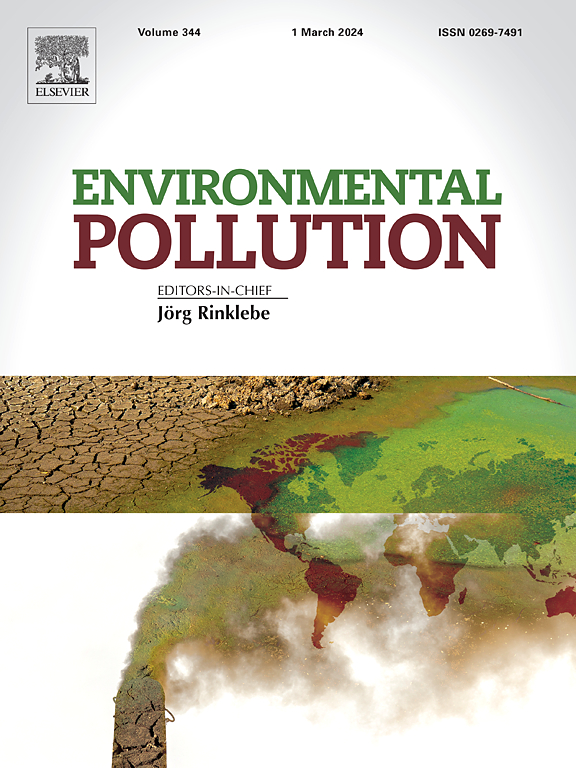What can grasshoppers reveal about metal pollution? A study of nickel smelter in Slovakia
IF 7.6
2区 环境科学与生态学
Q1 ENVIRONMENTAL SCIENCES
引用次数: 0
Abstract
Three-year biomonitoring compared the accumulation of 51 elements in grasshoppers (Euchorthippus declivus) from the vicinity of a former nickel smelter dump and two control sites. It was a positive finding that some major elements in the dump (Ni, Cr and Co, max. content 4.4, 9.4 and 0.24 μg/g dry body weight, respectively) decreased by 50–80 % in grasshoppers between 2021 and 2023. The concentrations of PM 10 and PM 2.5 also declined over time, potentially reflecting a reduction in the abovementioned elements. Although some minor elements (Pb, Sn, Cd, As, U, Th, and rare earth elements) did not exhibit a time-dependent decline, their concentrations remained significantly lower compared to other industrially impacted regions worldwide. Among herbs, the highest accumulation of elements was typically found in Convolvulus arvensis (Ni, Cr, Se, U, Th, Re) and/or in Setaria viridis (Cd, W, Sn, As). Correlation analyses revealed a positive relationship between elemental concentrations in herbs and grasshopper bodies, particularly in C. arvensis, suggesting its potential as an effective bioindicator of elemental pollution. The bioaccumulation factor (BAF, ratio of elemental content in grasshoppers to that in herbs) varied depending on plant species and locality: grasshoppers revealed indication (BAF ∼ 1, Fe, Ni, Co, and Mo), accumulation (BAF >1, Cu, Cd, Dy, U, Er, Yb) and exclusion (BAF <1, Cr, Mg, Rb, Sn, Re) values. Hierarchical cluster (HCA) and principal component analyses (PCA) confirmed a clear separation of the dump from the control sites based on the specific profile of the elements.

蚱蜢能揭示金属污染的什么信息?斯洛伐克镍冶炼厂的研究
为期三年的生物监测比较了来自前镍冶炼厂垃圾场和两个控制点附近的蝗虫(Euchorthippus declivus)体内51种元素的积累。这是一个积极的发现,一些主要元素在转储(Ni, Cr和Co,最大。含量分别为4.4、9.4和0.24 μg/g干重),在2021 - 2023年间下降了50-80%。pm10和PM 2.5的浓度也随着时间的推移而下降,可能反映了上述元素的减少。虽然一些次要元素(Pb、Sn、Cd、As、U、Th和稀土元素)没有随时间下降,但与全球其他受工业影响的地区相比,它们的浓度仍然明显较低。在草本植物中,元素积累量最高的是卷尾草(Ni, Cr, Se, U, Th, Re)和/或狗尾草(Cd, W, Sn, As)。相关分析显示,草本植物中元素浓度与蚱蜢体内元素浓度呈正相关,特别是在草蛾中,表明其可能是一种有效的元素污染生物指标。生物积累因子(BAF,即蚱蜢体内元素含量与草本植物中元素含量之比)因植物种类和地点的不同而不同:蚱蜢具有指示(BAF ~ 1, Fe, Ni, Co和Mo),积累(BAF >;1, Cu, Cd, Dy, U, Er, Yb)和排除(BAF <;1、Cr、Mg、Rb、Sn、Re)值。分层聚类分析(HCA)和主成分分析(PCA)根据元素的具体特征确认了垃圾场与控制站点之间的明确分离。
本文章由计算机程序翻译,如有差异,请以英文原文为准。
求助全文
约1分钟内获得全文
求助全文
来源期刊

Environmental Pollution
环境科学-环境科学
CiteScore
16.00
自引率
6.70%
发文量
2082
审稿时长
2.9 months
期刊介绍:
Environmental Pollution is an international peer-reviewed journal that publishes high-quality research papers and review articles covering all aspects of environmental pollution and its impacts on ecosystems and human health.
Subject areas include, but are not limited to:
• Sources and occurrences of pollutants that are clearly defined and measured in environmental compartments, food and food-related items, and human bodies;
• Interlinks between contaminant exposure and biological, ecological, and human health effects, including those of climate change;
• Contaminants of emerging concerns (including but not limited to antibiotic resistant microorganisms or genes, microplastics/nanoplastics, electronic wastes, light, and noise) and/or their biological, ecological, or human health effects;
• Laboratory and field studies on the remediation/mitigation of environmental pollution via new techniques and with clear links to biological, ecological, or human health effects;
• Modeling of pollution processes, patterns, or trends that is of clear environmental and/or human health interest;
• New techniques that measure and examine environmental occurrences, transport, behavior, and effects of pollutants within the environment or the laboratory, provided that they can be clearly used to address problems within regional or global environmental compartments.
 求助内容:
求助内容: 应助结果提醒方式:
应助结果提醒方式:


